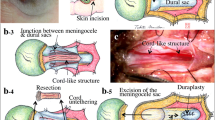Abstract
Background
A retained medullary cord (RMC) is a rare closed spinal dysraphism with a robust elongated neural structure continuous from the conus and extending to the dural cul-de-sac. One case extending down to the base of a subcutaneous meningocele at the sacral level has been reported.
Clinical presentation
We report on three cases of closed spinal dysraphism, in which a spinal cord-like tethering structure extended out from the dural cul-de-sac and terminated at a skin-covered meningocele sac in the sacrococcygeal region, which was well delineated in curvilinear coronal reconstructed images of 3D-heavily T2-weighted images (3D-hT2WI). Intraoperative neurophysiology revealed the spinal cord-like tethering structure was nonfunctional, and histopathology showed that it consisted of central nervous system tissue, consistent with RMC. The tethering structure histologically contained a glioneuronal core with an ependymal-like lumen and smooth muscle, which may indicate developmental failure during secondary neurulation.
Conclusions
When the RMC extending to a meningocele is demonstrated with the detailed magnet resonance imaging including 3D-hT2WI, decision to cut the cord-like structure for untethering of the nervous tissue should be made under careful intraoperative neurophysiological monitoring.




Similar content being viewed by others
References
Chakrabortty S, Oi S, Yoshida Y, Yamada H, Yamaguchi M, Tamaki N, Matsumoto S (1993) Myelomeningocele and thick filum terminale with tethered cord appearing as a human tail. Case report. J Neurosurg 78:966–969
Ersahin Y, Barcin E, Mutluer S (2001) Is meningocele really an isolated lesion? Childs Nerv Syst 17:487–490
Hashiguchi K, Morioka T, Fukui K, Miyagi Y, Mihara F, Yoshiura T, Nagata S, Sasaki T (2005) Usefulness of constructive interference in steady-state magnetic resonance imaging in the presurgical examination for lumbosacral lipoma. J Neurosurg 103:537–543
Lellouch-Tubiana A, Zerah M, Catala M, Brousse N, Kahn AP (1999) Congenital intraspinal lipomas: histological analysis of 234 cases and review of the literature. Pediatr Dev Pathol 2:346–352
McLone DG, Naidich TP (1985) Terminal myelocystocele. Neurosurgery 16:36–43
Morioka T, Hashiguchi K, Yoshida F, Nagata S, Miyagi Y, Mihara F, Sasaki T (2007) Dynamic morphological changes in lumbosacral lipoma during the first months of life revealed by constructive interference in steady-state (CISS) MR imaging. Childs Nerv Syst 23:415–420
Morioka T, Murakami N, Shimogawa T, Mukae N, Hashiguchi K, Suzuki SO, Iihara K (2017) Neurosurgical management and pathology of lumbosacral lipomas with tethered cord. Neuropathology 37:385–392
Morota N, Ihara S, Ogiwara H (2017) New classification of spinal lipomas based on embryonic stage. J Neurosurg Pediatr 19:428–439
Murakami N, Morioka T, Hashiguchi K, Yoshiura T, Hiwatashi A, Suzuki SO, Nakamizo A, Amano T, Hata N, Sasaki T (2013) Usefulness of three-dimensional T1-weighted spoiled gradient-recalled echo and three-dimensional heavily T2-weighted images in preoperative evaluation of spinal dysraphism. Childs Nerv Syst 29:1905–1914
Pang D, Zovickian J, Moes GS (2011) Retained medullary cord in humans: late arrest of secondary neurulation. Neurosurgery 68:1500–1519
Sala F, Barone G, Tramontano V, Gallo P, Ghimenton C (2014) Retained medullary cord confirmed by intraoperative neurophysiological mapping. Childs Nerv Syst 30:1287–1291
Tortori-Donati P, Rossi A, Cama A (2000) Spinal dysraphism: a review of neuroradiological features with embryological correlations and proposal for a new classification. Neuroradiology 42:471–491
Walsh JW, Markesbery WR (1980) Histological features of congenital lipomas of the lower spinal canal. J Neurosurg 52:564–569
Yun-Hai S, Nan B, Ping-Ping G, Bo Y, Cheng C (2015) Is repair of the protruded meninges sufficient for treatment of meningocele? Childs Nerv Syst 31:2135–2140
Acknowledgments
We thank Ann Turnley, PhD, from Edanz Group (www.edanzediting.com/ac) for editing a draft of this manuscript. This work was partly supported by Research Foundation of Fukuoka Children’s Hospital.
Author information
Authors and Affiliations
Corresponding author
Ethics declarations
Conflict of interest
The authors declare that they have no conflicts of interest.
Informed consent
Informed consent was obtained from all individual participants included in the study.
Rights and permissions
About this article
Cite this article
Murakami, N., Morioka, T., Shimogawa, T. et al. Retained medullary cord extending to a sacral subcutaneous meningocele. Childs Nerv Syst 34, 527–533 (2018). https://doi.org/10.1007/s00381-017-3644-2
Received:
Accepted:
Published:
Issue Date:
DOI: https://doi.org/10.1007/s00381-017-3644-2




